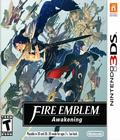Fire Emblem: Awakening functions as a pseudo-sequel to Fire Emblem: Shadow Dragon. Players join Chrom, the prince of Ylisse, in a bloody struggle. Ylisse is recovering from the reign of Chrom's father, a warmongering man whose battle splintered the continent. Only Chrom's sister, a pacifist and saintly woman, is holding things together. Unfortunately, the mad king of a neighboring kingdom wants to see the fragile peace shattered. Chrom and his army, the Shepherds, must stop the king and save Ylisse. The task is made more difficult by the mysterious masked Marth, who brings tidings of a great doom should Ylisse fall.
To those who've never played Fire Emblem, it's a turn-based strategy RPG where you and the enemy take turns moving and attacking one another. Each character automatically attacks during a combat action, with the number and success of the attacks determined by statistics. Fire Emblem is about positioning and mechanics with a small helping of luck on the side. You win or lose fights based on where you position your characters, which weapons you give them, and your mastery and knowledge of where and how the enemy is fighting. It may sound simple, but there's depth to be found, especially if you delve into the higher difficulty levels.
People have likely heard that Fire Emblem's difficulty can be rather punishing. One of the series' trademarks is "permadeath." A character who dies in battle remains dead. There are also no in-level saves, so the only way to save a character is to restart a level or soldier on without him or her. Fire Emblem: Awakening offers a few options for making the game easier — or harder, if you desire. There are two basic modes: Classic and Casual. Classic maintains everything mentioned above. Casual is friendlier, allowing defeated characters to return at the end of a stage. The multiple difficulty modes range from easy to insanely difficult.
New to English-speaking gamers, although not to the franchise, is the avatar mechanic. Previous Fire Emblem titles had a "lord," who functioned somewhat as the player's surrogate. Chrom is Awakening's lord, but he is joined by a player-created avatar. By default, the avatar has the Strategist class, which can use both swords and magic, but it can be converted to any other class. You're not obligated to use the avatar if you'd rather focus on your existing party members, but it's a nice feature.
The biggest addition to Awakening is an improved support mechanic. In prior games, support was a secondary mechanic unless you played on the harder difficulty modes. Two characters who fought alongside each other for a while could form "support" bonds that increased their joint stats. However, you had a limited number of supports, and it was easy for players to overlook the mechanic altogether. In Awakening, there's no longer a limit on supports. As long as two characters are compatible personality-wise, they can forge a friendship, and as long as they fight together for a while, they'll earn a support rank, ranging from C (good friends) to A (best friends). Form a lot of friendships, and your characters will be way more effective at fighting together.
When a character attacks while standing beside a friend, there is a chance the friend activates a Support Action: a support attack (attack together) or a support defense (negate damage or counter-attack). The activation rate is initially very low, but as characters form bonds and level up, the chances of activating Support Actions drastically increases. People who fight together tend to continue to fight together.
As for the new Pair Up mechanic, you can pair up two units at any time, causing one to become the "main" unit and the other to become its support unit. The latter functions as the permanent Support Action partner, granting the main character a tremendous stat boost.
Another big difference in Awakening is in the leveling. In most Fire Emblem games, you have a set and linear progression: each character has about 40 levels, with about 20 levels of a basic class and 20 levels of a promoted class. Awakening makes this more complex by adding Second Seals. At any time after you acquire a Second Seal item, you can use it to "reclass" a character into another available class. Second Seals allow you to learn skills from different classes, and this unlocks special attacks that can help you survive fatal blows and reduce enemy statistics, among other bonuses. Most importantly, these skills are not lost when you change to another class or level up.
Fire Emblem: Awakening is shaping up to be the best Fire Emblem to date. It combines a staggering array of new mechanics with a customizable difficulty that should be easy enough for newcomers but meaty enough experienced Fire Emblem vets. There's a lot of content even without the DLC, and the mechanics are varied enough that newcomers and long-time players alike should have little trouble hopping right in and having fun. Fire Emblem: Awakening is due Feb. 4, 2013, for the Nintendo 3DS, and it will be available through both digital and physical distribution.
More articles about Fire Emblem: Awakening











 Fire Emblem Awakening offers a unique blend of in-battle strategy, vast character customization, and lush 3D cinematic graphics.
Fire Emblem Awakening offers a unique blend of in-battle strategy, vast character customization, and lush 3D cinematic graphics.













